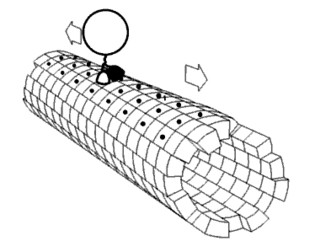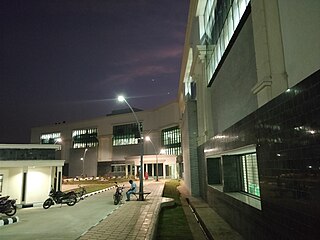Related Research Articles

Biophysics is an interdisciplinary science that applies approaches and methods traditionally used in physics to study biological phenomena. Biophysics covers all scales of biological organization, from molecular to organismic and populations. Biophysical research shares significant overlap with biochemistry, molecular biology, physical chemistry, physiology, nanotechnology, bioengineering, computational biology, biomechanics, developmental biology and systems biology.

The Max Planck Institute for Biophysical Chemistry, also known as the Karl-Friedrich Bonhoeffer Institute, was a research institute of the Max Planck Society, located in Göttingen, Germany. On January 1, 2022, the institute merged with the Max Planck Institute for Experimental Medicine in Göttingen to form the Max Planck Institute for Multidisciplinary Sciences.
The Sackler Prize can indicate any of the following three awards established by Raymond Sackler and his wife Beverly Sackler.
Dorothee Kern, is a professor of Biochemistry at Brandeis University and former player for the East German national basketball team.

Tata Institute of Fundamental Research is a public research institution in Hyderabad, India. Then Prime Minister of India Manmohan Singh laid the foundation stone for the institute on 19 October 2010. It has operated on a campus of 209 acres (85 ha) near the Hyderabad Central University since moving in October 2017 from a temporary campus in Narsingi.
Food physical chemistry is considered to be a branch of Food chemistry concerned with the study of both physical and chemical interactions in foods in terms of physical and chemical principles applied to food systems, as well as the applications of physical/chemical techniques and instrumentation for the study of foods. This field encompasses the "physiochemical principles of the reactions and conversions that occur during the manufacture, handling, and storage of foods"
The following outline is provided as an overview of and topical guide to biophysics:
Michael F. Brown is an American chemist. Since 1987, he has been a Professor of Chemistry at the University of Arizona, and since 2003 has held joint appointments as a Professor of Physics and Professor of Applied Mathematics. Prior to the University of Arizona, Brown earned tenure at the University of Virginia. His research involves the application of NMR spectroscopy and other biophysical methods to study membrane lipids, liquid crystals, and membrane proteins. Brown has particularly been a pioneer in the application of solid-state NMR spectroscopy to the study of lipid bilayer dynamics.

G. Marius Clore MAE, FRSC, FRS is a British-born, Anglo-American molecular biophysicist and structural biologist. He was born in London, U.K. and is a dual US/U.K. Citizen. He is a Member of the National Academy of Sciences, a Fellow of the Royal Society, a NIH Distinguished Investigator, and the Chief of the Molecular and Structural Biophysics Section in the Laboratory of Chemical Physics of the National Institute of Diabetes and Digestive and Kidney Diseases at the U.S. National Institutes of Health. He is known for his foundational work in three-dimensional protein and nucleic acid structure determination by biomolecular NMR spectroscopy, for advancing experimental approaches to the study of large macromolecules and their complexes by NMR, and for developing NMR-based methods to study rare conformational states in protein-nucleic acid and protein-protein recognition. Clore's discovery of previously undetectable, functionally significant, rare transient states of macromolecules has yielded fundamental new insights into the mechanisms of important biological processes, and in particular the significance of weak interactions and the mechanisms whereby the opposing constraints of speed and specificity are optimized. Further, Clore's work opens up a new era of pharmacology and drug design as it is now possible to target structures and conformations that have been heretofore unseen.
Cynthia Larive is an American scientist and academic administrator serving as the chancellor of University of California, Santa Cruz. Larive's research focuses on nuclear magnetic resonance spectroscopy (NMR) and mass spectrometry. She was previously a professor of chemistry and provost and executive vice chancellor at the University of California, Riverside. She is a fellow of AAAS, IUPAC and ACS, associate editor for the ACS journal Analytical Chemistry and editor of the Analytical Sciences Digital Library.

Gerhard Wagner is a German-American physicist currently the Elkan Rogers Blout Professor of Biological Chemistry and Molecular Pharmacology at Harvard Medical School and is an Elected Fellow of the American Association for the Advancement of Science, German National Academy of Sciences Leopoldina, American Academy of Arts and Sciences, National Academy of Sciences and International Society of Magnetic Resonance. He is considered one of the pioneers in Biological Nuclear Magnetic Resonance (NMR) spectroscopy (Bio-NMR) and his research has been focused on protein structure, dynamics and stability, and on the relation of these to protein function. He is a structural biologist and is recognized for his work on the development of NMR spectroscopy for determination of protein structures in solution and characterizing protein dynamics.
Attila Szabo is a biophysicist who is a Distinguished Investigator and Section Chief of the Theoretical Biophysical Chemistry Section in the Laboratory of Chemical Physics at the National Institute of Diabetes and Digestive and Kidney Diseases, part of the United States National Institutes of Health.

William Allen Eaton is a biophysical chemist who is a NIH Distinguished Investigator, Chief of the Section on Biophysical Chemistry, and Chief of the Laboratory of Chemical Physics at the National Institute of Diabetes and Digestive and Kidney Diseases, one of the 20 Institutes of the United States National Institutes of Health.

James J. Chou (周界文) is a Chinese American scientist and Professor of Biological Chemistry and Molecular Pharmacology at the Harvard Medical School. He is known for pioneering the use of Nuclear Magnetic Resonance (NMR) Spectroscopy to reveal the structural details of the membrane regions of cell surface proteins, particularly those of immune receptors and viral membrane proteins.

Helen Jane Dyson is a British-born biophysicist and a professor of integrative structural and computational biology at the Scripps Research Institute in La Jolla, California. She is also currently editor-in-chief of the Biophysical Journal.
Susan Lowey is an American biophysicist researching the structure and function of contractile proteins. She currently teaches in the Department of Molecular Physiology & Biophysics at the University of Vermont and is a fellow of the American Academy of Arts and Sciences as well as the Biophysical Society.

Roberta F. Colman, born Roberta Fishman, was an American biochemist.

Dagmar Ringe is an American biochemist, educator, and researcher. She is the Harold and Bernice Davis Professor in Aging and Neurodegenerative Disease at Brandeis University in Waltham, Massachusetts and holds appointments in the departments of Chemistry and Biochemistry.
Jean Baum is an American chemist. She is the Distinguished Professor of Chemistry and Chemical Biology at Rutgers University, where she is also Vice Dean for Research and Graduate Education in the School of Arts and Sciences, and also Vice Chair of the Department of Chemistry and Chemical Biology. Her research investigates protein–protein interaction and protein aggregation using nuclear magnetic resonance spectroscopy (NMR) and other biochemical and biophysical techniques. She serves as Treasurer for the Protein Society.

Gaetano T. Montelione is an American biophysical chemist, Professor of Chemistry and Chemical Biology, and Constellation Endowed Chair in Structural Bioinformatics at Rensselaer Polytechnic Institute in Troy, NY.
References
- ↑ "Herzfeld Page". Brandeis University, Department of Chemistry. Retrieved 24 January 2012.
- ↑ "Publications of Judith Herzfeld". Google Scholar.
- ↑ Herzfeld, Judith (February 1987). Sense & Sensibility in Childbirth: A Guide to Supportive Obstetrical Care (W.W.Norton). ISBN 0393303810.
- ↑ "ConcepTests for General Chemistry".